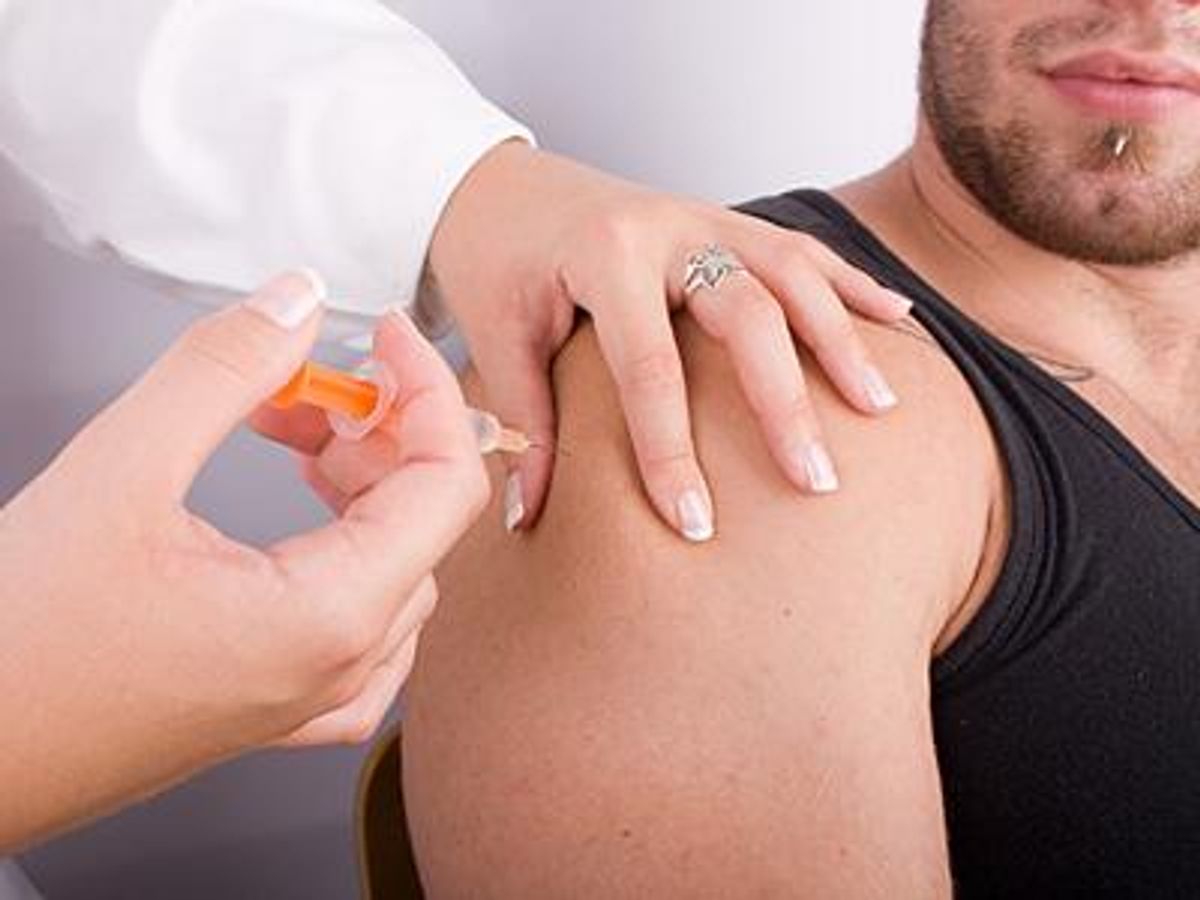As increasingly scary warnings came out of New York about a particularly deadly variant of meningococcal disease (bacterial meningitis) was showing up in gay men in New York, authorities began recommending vaccinations for gay and bisexual men in New York City who are either HIV-positive or HIV-negative and non-monogamous. The vaccination warning also included men in the two categories above who visited New York City at any time since September of 2012. But the warnings from both New York City and New York State on this matter have been somewhat confusing, so I sought out an expert at the CDC, Dr. Clark, to explain what’s actually going on, and who really needs to get a shot. Let me walk you through what I learned.
Who should get a meningitis shot?
Anyone covered by the recommendations from New York City and New York state — if you can make sense of them. But also, really, anyone who’s concerned enough about the outbreak. I asked Dr. Clark if there was any downside to the vaccine, and he said no. The vaccine carries no more risk than any other vaccine you might take. And to further put one’s mind at ease, the meningitis vaccine does not contain a live bacteria, or even a dead one — it only contains part of the shell of the bacteria, so it’s impossible for it to give you meningitis. Thus, Dr. Clarks’s recommendation, that if you’re worried at all, get the shot.
How is this variant of meningitis transmitted?
I was quite surprised about how the bacteria is transmitted. As the New York warnings are targeted at gay men, and specifically at men who seek sex partners online, at a party, or at a bar, I just assumed that this was sexually transmitted. It’s not. The bacteria is transmitted through secretions of the mouth, nose, and throat — large-sized droplets. What that means is the droplets are far too large to float in the air. So it’s the kind of thing you’re more likely to get from French kissing, or having someone cough in your face or accidentally spit in your face while talking, or even sneezing, but regular aerosolized drops in sneezes won’t get you sick, it’s the larger droplets that do it. That’s why the warnings talked about “close contact.” What they found was that people living together, even if they’re not in a romantic relationship, we’re at a “very high risk” of contracting the disease from each other.
Can meningitis be transmitted by sex?
No, but…not only are the mouth, nose and throat instrumental for transmitting the bacteria, they’re also instrumental for receiving the bacteria. So oral sex isn’t going to transmit it, so long as your mouth doesn’t come into contact with anyone else’s saliva. The same goes for any other sex act, the key issue is your mouth (or nose) coming into contact with someone else’s saliva. I was surprised about that, since I figured this would be transmitted similarly to an STD. Not so, said Dr. Clark. Even though the bacteria is a cousin of the bacteria that causes gonorrhea, while gonorrhea adapted to the genital tract as a venue of transmission, this bacteria adopted to the nose and throat. It is also not as easily spread as an STD.
You’re not at risk if you work with someone who gets sick.
Because the bacteria requires prolonged face-to-face contact, simply working in an office alongside someone who came down with meningitis would not put you at risk, Dr. Clark told me.
Are people with HIV more likely to contract meningitis?
This one is tricky. What they’ve found is that being HIV-positive does not per se put you at risk of catching this variant of meningitis, as being HIV-positive can for other infections. So it’s not really a question of having a depressed immune system and thus being more likely to get the disease. But, they’ve found some kind of correlation between being HIV-positive and becoming infected during this outbreak: Many, but not all, of those infected are HIV-positive.
It could be something as simple as HIV-positive people in New York generally having sex with other HIV-positive people in that same community. Thus, if someone becomes infected in that community, he is more likely to pass it to other members of that community. So the bacteria stays within the HIV-positive community because it’s a discrete community, not because HIV makes you more prone to catch it. That isn’t necessarily the reason HIV-positive people in New York City are coming down with this disease, but it is an example of how HIV doesn’t put you at risk of catching the disease, yet your HIV status could still be relevant to whether you’re at a heightened risk.
Will the meningitis vaccine help after you’re exposed?
No. If your doctor thinks you’ve been exposed, or you’re already showing symptoms, they will prescribe antibiotics. The vaccine is only good before you’re exposed.
How quickly does the vaccine work and how long does it last?
The meningitis vaccine takes two weeks to fully kick in, and should protect you for three to five years. People with HIV may not respond as well to the vaccine, so it’s recommended that they receive two doses — a booster shot, in essence – two to three months apart. And regardless of your status, if you remain at risk, they recommend a booster after five years.
Now, having said that, the vaccine doesn’t always work. While it works in the majority of cases, the 21-year-old University of Wisconsin-Madison student who died of meningitis had reportedly gotten the vaccine, a booster, before starting college. It didn’t work, or, it didn’t work well enough or long enough. (It remains unknown whether his case is related to the New York City outbreak, but it's thought not to).
Can you be exposed and not get sick?
Yes. Some people are exposed to meningitis and don’t get sick at all. Others are exposed and develop an immune response to the bacteria without becoming visibly ill, and without even knowing it. You will not, however, be a “carrier” of the disease if that happens to you. You would only be contagious during the same time period that anyone else with the disease would be contagious. (Though I didn’t clarify with Dr. Clark how long that would be in the case of someone who didn’t show any symptoms; nonetheless, it didn’t see like a long time, as he said you wouldn’t be a carrier, and you wouldn’t be contagious once you’re body developed the immunity.)
How long are people contagious?
The good thing and bad thing about this disease is that you generally get sick a day or two after you were exposed, though it’s possible, but unlikely, for it to take up to two weeks. The bad news is that you can become quite ill quickly, and if you don’t get medical help you can die. The good news is that the quick onset of the disease makes it harder to spread. Why? Because once you’re in bed sick as a dog, you really don’t feel like going online and hooking up, or going to a bar and drinking with your buddies. So the disease generally only gets a chance to spread in that 24 to 48 hour window after you’re first exposed and still feeling fine, which thus limits the spread of the disease.
Is this a gay disease?
No. I mentioned to Dr. Clark that some of the readers were confused as to why the warning went out to the gay community and not the straight community as well. How could a disease target only gay people? He said that it’s not a “gay” disease, and that meningitis usually targets schools, college campuses, and corrections facilities (i.e., a small enclosed communities). Occasionally, the disease can hit a virtual community, like the gay community. By “virtual,” he means that gay men are not a geographically-confined community, as are kids in the same high school building or college dorm, or men living in the same prison. So the community is more “virtual,” as the tie isn’t immediate geographic proximity per se (though obviously it’s affecting people within a discrete geography like New York City, but that’s different than actually living together in the same building and thus you all get sick).
Also, 98% of the cases in the U.S. every year are sporadic, they occur by themselves, rather than striking a community. Only a small fraction turn into “outbreaks” like this one in New York.
One more thing Dr. Clark noted was that this disease tends to strike in specific clusters, in specific communities, and it tends to stay confined to that community, without spreading to other communities. And that’s another reason why the warnings are only being given to gay men, and only, so far, in New York City.
Just how big is this outbreak?
Not big at all, actually, but big enough to be concerned. There was one case in 2010, four in 2011, and 13 in 2012. Those numbers may look small, but in public health terms, they’re not. What has experts worried is that they keep hitting the same community, gay men in New York City, and it’s not going away. Most outbreaks happen quickly, Dr. Clark told me, with usually just a few cases occurring at once in a short period of time, and then they go away. This has been going on in New York City since 2010 and it’s growing, rather than going away. Thus the concern.
I asked Dr. Clark about the concerns some people had that the current outbreak was blown out of proportion by the authorities in NY. He says that’s not true at all. Here’s why.
In public health terms, an “outbreak” is defined as 10 cases per 100,000 people within a short period of time (say, a few weeks). When you have an outbreak, that’s suggestive that the disease has reached a point where it may accelerate and spread to even more people. In public health circles, it’s their job to stop outbreaks from becoming something bigger. To the public, these numbers sound small. But in public health terms, these numbers are statistically significant and worthy of increased concern.
That’s why when they get two or three cases in a school of 600 kids, or a prison of a few thousand inmates, they vaccinate everyone to prevent the disease’s spread. That’s enough cases to set off alarm bells.
In NYC, we’re talking more on the order 13 or so cases last year. But, you might say, hey, that’s 13 cases for 8 million people, so who cares? But that’s not really correct. It’s not 8 million New Yorkers. It’s gay New Yorkers. And it’s only gay men who are getting sick, not lesbians, so now the number is cut down even fewer. And it’s not all gay men in NYC; it’s gay men in certain boroughs. And it’s not every gay men in those boroughs, it seems to be gay men in those boroughs who are sexually active and particularly using Web sites, phone apps, bars, and parties to meet guys. That cuts down the number even further. So you’re now a lot closer to that 100,000 figure than you were when you thought this was about 8 million New Yorkers.
The uncertainty of the size of the community exposed to this disease is part of what worries public health professionals. It’s not possible to accurately define whether we’re talking 13 cases per 100,000, per 200,000 or per 50,000. So they err on the side of caution because this is such a particularly deadly variant of the disease, killing one in every three people who get it, rather than the normal one in five. And in public health, you try to cut off disease before they become a huge problem. Thus you have to look at small numbers, and historically what those numbers tend to mean for the future, and act accordingly.
John Aravosis, editor of AMERICAblog, joint JD/MSFS from Georgetown, worked in the U.S. Senate, World Bank, Children's Defense Fund, and as a stringer for the Economist. A frequent TV pundit, he has been on The O'Reilly Factor, Hardball, World News Tonight, Nightline and Reliable Sources. He can be found on Twitter @aravosis. This article originally appeared on AMERICAblog.com.

















































































